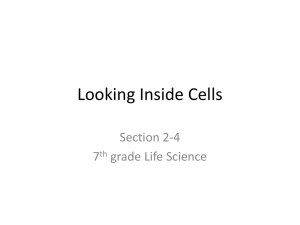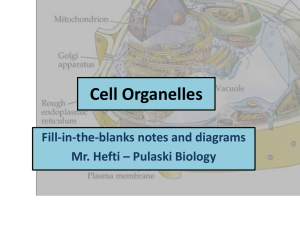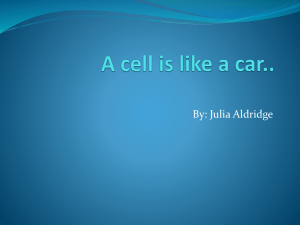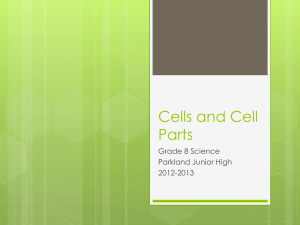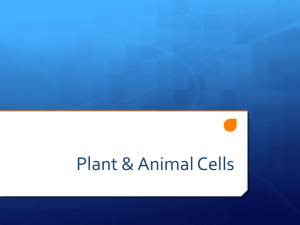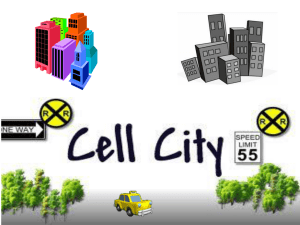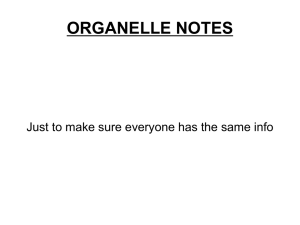Chapter 3_2
advertisement
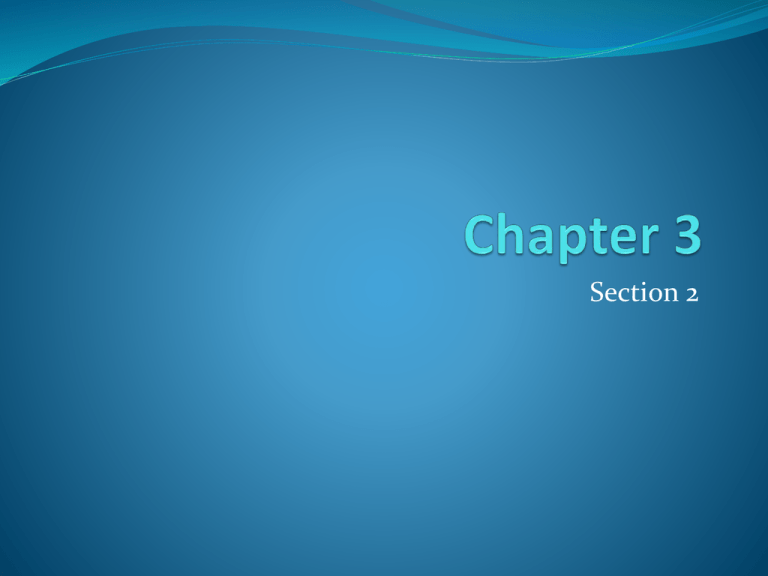
Section 2 Vocabulary – Need 14 Cards 1. organelle A tiny cell structure that carries out a specific function within the cell. 2. Cell wall A rigid layer of nonliving material that surrounds the cells of plants and some other organisms. 3. cytoskeleton A protein “framework” inside a cell that gives the cell a shape. Vocabulary – Need 14 Cards 4. cell membrane The outside cell boundary that controls which substances can enter or leave the cell. 5. nucleus The control center of a eukaryotic cell that directs the cell’s activities and contains the information that determines the cell’s form and function. 6. cytoplasm The material within a cell apart from the nucleus. Vocabulary – Need 14 Cards 7. mitochondria Rod shaped cell structures that convert energy in food molecules to energy the cell can use to carry out its functions. 8. endoplasmic reticulum A cell structure that forms passageways in which proteins and other materials are carried through the cell. 9. ribosome A small grain-like structure in the cytoplasm of a cell where proteins are made. Vocabulary – Need 14 Cards 10. Golgi body A structure in a cell that receives proteins and other newly formed materials from the endoplasmic reticulum, packages them, and distributes them to other parts of the cell. 11. chloroplast A structure in the cells of plants and some other organisms that captures energy from sunlight and uses it to produce food. 12. vacuole A sac inside a cell that acts as a storage area. Vocabulary – Need 14 Cards 13. lysosome A small, round cell structure containing chemicals that break down large food particles into smaller ones. They also break down old cell parts and release the substances so they can be used again. 14. interact (in tur AKT) v. To act upon one another. Most people interact with other employees at work. Division of Labor How are jobs in a town divided up among people? Why is it effective to divide the labor in this way? Cell wall and Cell membrane When Hooke observed cork cells, what he saw was the cell wall. Look at and read the caption for Figure 5. What shape do the cell walls give to the onion root cells? Rectangular What is the function of the cell wall? It helps protect and support the cell. What is the function of the cell membrane? It controls what substances come into and out of a cell. Cell wall and Cell membrane Which of these structures do plant cells have? Plant cells have both a cell wall and a cell membrane. Which of these structures do animal cells have? Animal cells only have cell membranes, not a cell wall. Why does a cell with a cell wall need a cell membrane? The cell wall separates the cell from the outside environment, but it cannot control all substances that come into and out of the cell. Plant Cell Animal Cell DE Videos Parts of a Plant Cell Parts of an Animal Cell Venn Diagram Plant Cell Animal Cell Homework Study your flashcards! Complete your diagrams and labeling! Functions of the Nucleus What is the function of the nucleus? The nucleus directs all of the cell’s activities. What keeps material in the nucleus from spilling out? The nucleus is surrounded by the nuclear envelope. Functions of the Nucleus How does the nucleus “know” how to direct the cell? Thin strands of chromatin in the nucleus contain genetic material, the instructions for directing the cell’s functions. What is the nucleolus? It is where organelles that make proteins are produced. Functions of the Nucleus Where in the nucleus is genetic material found? Genetic material is found in strands called chromatin. How is the nucleus like the manager of a company? How is a cookbook like the genetic code? Cytoplasm Cytoplasm is a clear, thick, gel-like fluid that is constantly moving. Inside the cytoplasm are many organelles. Each organelle performs a specific function. Mitochondria Known as the “powerhouses” of the cell because they convert energy in food molecules to energy the cell can use to carry out its functions. Endoplasmic Reticulum A cell structure that forms passageways in which proteins and other materials are carried through the cell. Similar to a system of hallways in a building. Ribosomes Small, grain-like Attached to the surface of the endoplasmic reticulum or floating in the cytoplasm. Protein producing factories. Golgi Bodies Looks like flattened sacs and tubes. Thought of as the cell’s mail room. Receives proteins and other newly produced materials from the endoplasmic reticulum. Then packages and distributes materials to other parts of the cell. Also releases material outside the cell. Chloroplasts Only plant cells (and some other organisms) have chloroplasts. Capture energy from sunlight and use it to produce food. Make leaves green! Vacuoles Water filled sac Floats in cytoplasm Storage area of the cells Store food, waste products, and other needed materials. Plant cells have one large central vacuole. Some animal cells have smaller storage organelles Lysosomes Small, round structures Contain chemicals that break down certain materials Break down large food into smaller food. Break down old cell parts for reuse. Can be considered the cell’s “clean up crew” Functions of Organelles How do ribosomes, Golgi bodies, and the endoplasmic reticulum work together? Ribosomes make proteins that are released through the endoplasmic reticulum and moved to the Golgi bodies. Golgi bodies move materials around and outside the cell. Functions of Organelles How do chloroplasts, mitochondria, lysosomes, and vacuoles work together in plant cells? Chloroplasts capture the sun’s energy and use it to make food for the cell. Mitochondria convert energy in food to energy the cell can use. Lysosomes break down materials, including food particles. Vacuoles store food and other materials the cell needs. Apply Why are chloroplasts found only in plant cells? Only plants have the ability to capture energy from sunlight and make food. How Cells Differ Cells have different structures because of their functions. Compare the nerve cell (Figure 11) to the red blood cells. The nerve cell has extensions, and the red blood cells look flattened. How do you think each cell’s shape helps it do its job? The extensions on nerve cells help them reach out and send messages to other cells; the flatness of red blood cells helps them squeeze through tiny blood vessels. Homework Pg. 64 Worksheet Visit www.exploratorium.edu/traits/cell_explorer.html Write down five interesting facts that you learned. Write down what you liked about the website. Project – Due Fri. Dec. 9 Gelatin Cell: Make your own model of a cell Pg. 92 in your text book has directions. Tips Use a pan for a plant cell. Use a resealable plastic bag for an animal cell. Use warm, not hot, water Stir the gelatin until it dissolves completely and chill for up to an hour before adding the cell structures. Bring to class as soon as you finish to share throughout the week with a key.


